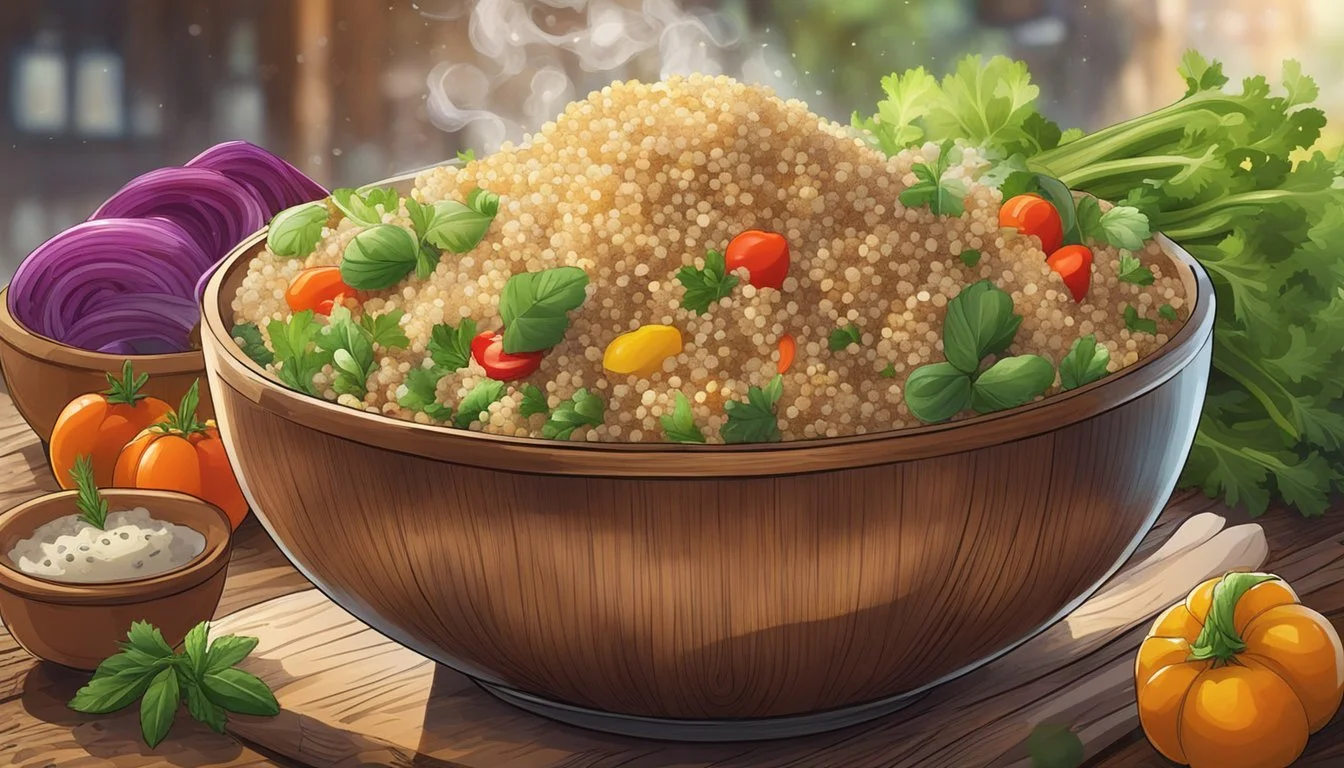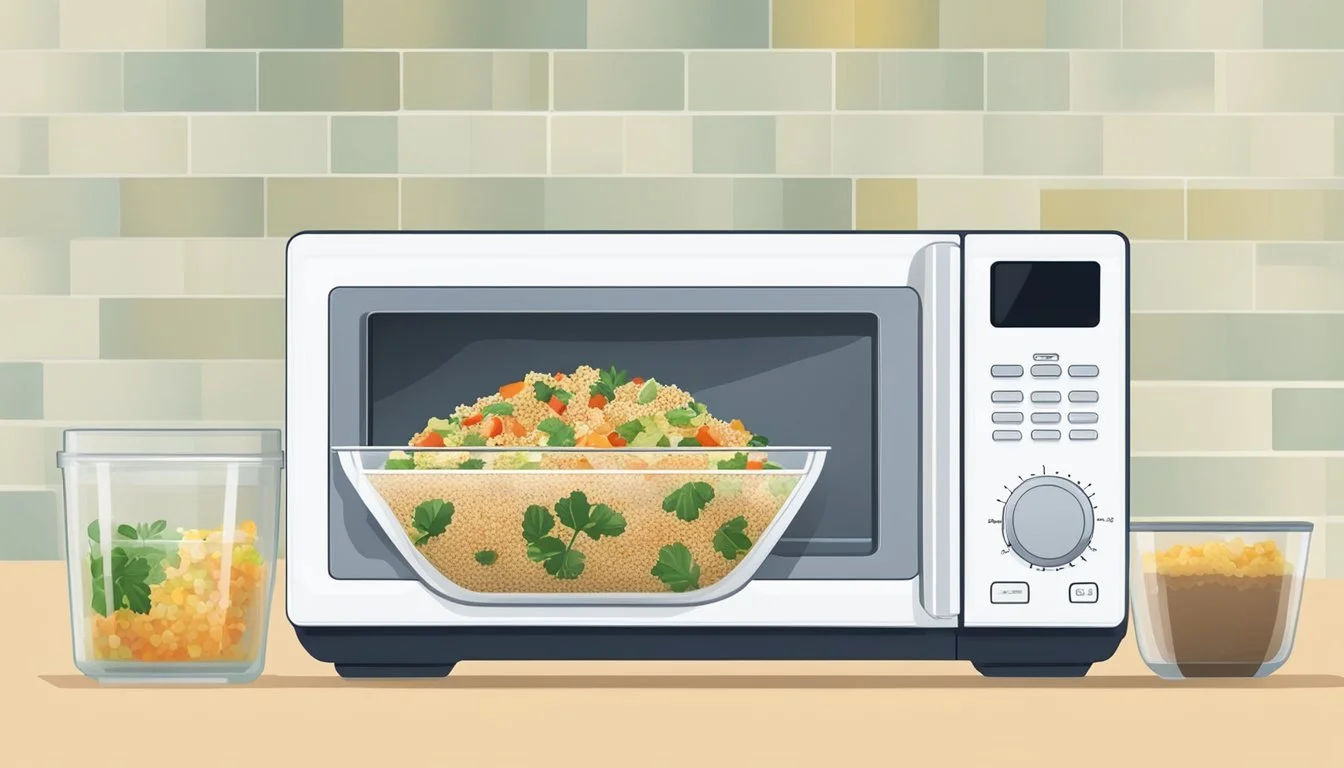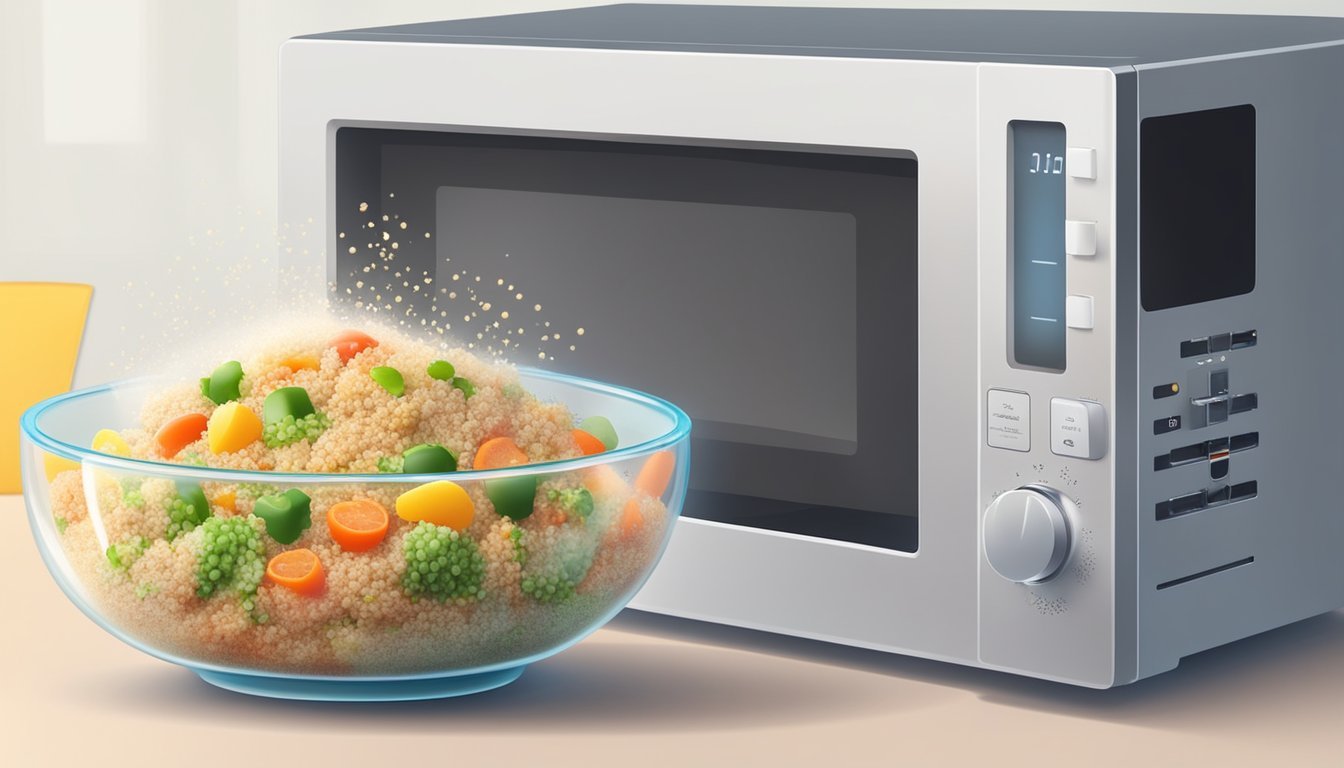Best Way to Reheat a Quinoa Salad
Ensuring Fluffiness Every Time
Reheating quinoa (What wine goes well with quinoa?) effectively to maintain its fluffiness can be a challenge, particularly when it's part of a quinoa salad. Leftover quinoa has a tendency to become dense and lose its appealing texture when not reheated with care. Nevertheless, with the correct approach, one can restore the freshness and lightness of the salad's base, making it nearly indistinguishable from its freshly cooked state.
When aiming to reheat a quinoa salad, the method used is paramount. Quinoa is delicate and requires a gentle touch to avoid turning a fluffy grain into a mushy disappointment. The microwave is often the go-to appliance because of its convenience and speed. Utilizing a microwave-safe bowl, a damp paper towel can be employed to cover the quinoa, creating a steaming effect that reheats without drying out the grains.
In addition to the microwave, quinoa can also be refreshed using a stovetop or an oven, though these methods might be better suited for quinoa that is part of a warmer dish rather than a cold salad. The key lies in using a low to medium heat and stirring frequently to encourage even heat distribution. By covering the quinoa during reheating, steam is trapped, which assists in keeping the quinoa moist and fluffy. Regardless of the method, it is important to heat only until the desired temperature is reached to preserve the quality of the quinoa salad.
Understanding Quinoa
In exploring the best methods to reheat a quinoa salad, one must first appreciate quinoa’s nutritional value, diverse varieties, and storage requirements to maintain its quality.
Nutritional Benefits
Quinoa is a highly nutritious seed, revered for its complete protein content, implying that it contains all nine essential amino acids required by the human body. Each serving of quinoa is packed with fiber, which aids digestion, and is a great option for those seeking gluten-free alternatives.
Nutrient Benefit Protein Supports muscle development and repair Essential Amino Acids Crucial for bodily function Fiber Enhances digestive health Gluten-Free Suitable for gluten intolerance
Quinoa Varieties
Quinoa comes in various forms, primarily white, red, and black. Each variety offers a slightly different texture and flavor profile, but all can be used interchangeably based on personal preference.
White Quinoa: Also known as ivory quinoa, it's the most common, with a light flavor and fluffiest texture once cooked.
Red Quinoa: It maintains a firmer texture post-cooking, ideal for salads (What wine goes well with salads?) and recipes needing structure.
Black Quinoa: With an earthy taste, it's slightly sweeter and retains the firmest texture, adding a crunch to dishes.
Proper Storage Techniques
To extend quinoa's shelf life and maintain its fluffiness, proper storage techniques are imperative. Cooked quinoa (how long does cooked quinoa last?) should be cooled to room temperature before storing to prevent moisture buildup.
Refrigerator: Store cooked quinoa in an airtight container and keep it in the refrigerator for up to five days.
Freezer: To freeze quinoa, spread it on a baking sheet to cool, then transfer it into an airtight container or freezer bag. It can last up to one month in the freezer, ensuring a quick and healthy meal component is always at hand.
Pre-Reheating Preparations
Before reheating a quinoa salad, one must ensure that the quinoa's texture remains fluffy and its flavor intact. Proper moisture and assessing the condition of the quinoa are crucial steps.
Assessing Quinoa Condition
Firstly, one should inspect the leftover quinoa to determine its current state. If the quinoa was rinsed properly before its initial cooking, it should retain a fluffier texture even after being refrigerated.
Look for:
Clumps that might indicate moisture loss
Dry edges that could affect even reheating
Any discoloration that suggests spoilage
This evaluation directs how much additional moisture may be needed to restore the quinoa to its original state.
Adding Moisture to Prevent Dryness
Quinoa requires a delicate balance of moisture to maintain its fluffy texture during reheating. One should not simply reheat quinoa without introducing some liquid to the dish, as this can result in dry, unpalatable grains.
Steps to ensure proper moisture:
Drizzle a small amount of liquid (water or broth) over the quinoa – just enough to dampen it without making it soggy.
Lay a damp paper towel over the bowl. This traps steam and disperses moisture evenly during the reheating process.
Adding moisture, combined with careful heating, ensures the quinoa salad retains its desired flavor and fluffy texture.
Reheating Methods
When reheating quinoa salad to maintain its fluffy texture, the method used can greatly impact the result. One should employ careful temperature control and even heating to preserve the salad's quality.
Stovetop Method
Using the stovetop enables close monitoring of the quinoa's temperature. For effective reheating, place the quinoa in a pan on the stove over low heat. The quinoa should be stirred regularly with a fork to ensure even heating and to maintain fluffiness. It's important to not overcook as this can lead to dryness.
Microwave Method
For a quick reheating option, the microwave is suitable. Place quinoa in a microwave-safe bowl and use a fork to fluff it up, breaking apart any clumps. Cover with a damp paper towel to create steam. Heat on medium power for intervals of 30 seconds, stirring each time to promote uniform warmth without over-drying.
Oven Method
The oven method is fitting for reheating larger quantities of quinoa. Spread the quinoa in an oven-safe dish and lightly moisten with a sprinkle of water to prevent dryness. Cover the dish with a lid or aluminum foil to trap steam which facilitates even reheating. Warm the quinoa in a preheated oven, set at a low temperature to avoid excessive dryness, stirring occasionally.
Maintaining Fluffiness and Flavor
When reheating a quinoa salad, it's essential to use techniques that preserve its fluffiness and enhance its flavor, avoiding a mushy or bland outcome.
Stirring Techniques
To maintain the fluffiness of quinoa, gentle and strategic stirring is key. Begin by fluffing the quinoa with a fork before reheating to separate grains. Here are the steps:
Break up clumps: Use a fork to gently break any big clumps of quinoa.
Even distribution: Stir the quinoa lightly after heating to ensure heat distribution without compacting the grains.
Consistent stirring minimizes the risk of overcooking, which can result in a loss of the quinoa's prized fluffy texture.
Seasoning Adjustments
Seasonings are essential for enhancing the flavor of reheated quinoa salad. As quinoa can become bland when cooled, consider adding a small amount of broth or lemon juice to introduce moisture and tanginess. Here's how to do it:
Broth: Add a tablespoon of vegetable or chicken broth before reheating to revitalize the quinoa's inherent nuttiness.
Amount of Quinoa Broth Quantity 1 cup 1 tablespoon 2 cups 2 tablespoons
Lemon juice: A splash of lemon juice can brighten up the quinoa, providing a zesty note and enhancing its overall flavor profile.
Amount of Quinoa Lemon Juice Quantity 1 cup ½ teaspoon 2 cups 1 teaspoon
Stir these liquids into the quinoa before reheating to ensure the seasonings are well incorporated throughout the salad.
Creative Quinoa Uses Beyond Salads
While quinoa salads are a popular and healthy choice, this versatile grain can be incorporated into a variety of other dishes. By exploring its potential in soups, breakfast options, and savory snacks, (What wine goes well with savory snacks?) one can elevate their meal prep to new heights.
Soups and Stews
Quinoa acts as an excellent thickener for soups and stews, adding a nutritious boost. Try stirring in cooked quinoa during the last minutes of cooking your favorite vegetable soup. For a more substantial meal, chefs might use quinoa as the base grain in a hearty chicken or beef stew, (What wine goes well with beef stew?) absorbing flavors and providing a satisfying texture.
Chicken Stew with Quinoa:
Ingredients: Chicken, carrots, celery, onions, quinoa, broth.
Cook Time: Quinoa added for the last 15 minutes.
Ingredients: Assorted vegetables, quinoa, vegetable broth, seasoning.
Cook Time: Add quinoa with vegetables, simmer until fully cooked.
Breakfast Options
A quinoa breakfast bowl serves as a high-protein start to the day, mixing in nuts, fruits, and a drizzle of honey. For those seeking an alternative to traditional oatmeal, warm quinoa topped with cinnamon, apples, or berries provides a comforting and energizing breakfast.
Warm Quinoa Breakfast Bowl:
Top with: Sliced almonds, blueberries, a hint of cinnamon.
Quinoa Porridge:
Combine with: Milk or a milk alternative, cook until creamy.
Savory Snacks and Sides
Quinoa can be formed into crisp quinoa patties, ideal for a snack or to complement a main dish. These can be seasoned with herbs and spices and pan-fried to a golden brown. Additionally, quinoa is perfect for stuffed peppers, adding texture and protein to the filling.
Quinoa Patties:
Mix: Cooked quinoa, egg, breadcrumbs, seasoning.
Cook: Pan-fry until crispy on both sides.
Stuffed Peppers with Quinoa:
Mix with: Tomatoes, beans, cheese, and bake until peppers are tender.
By integrating quinoa into different meals, it becomes an adaptable commodity in the kitchen, transitioning from a side dish to the star of a stir fry or the heart-warming staple of a winter soup. Its universality in various meal categories makes it an asset for those planning their weekly meal prep.
Advanced Tips and Considerations
When it comes to reheating a quinoa salad, understanding the nuances of freezing and defrosting can make a significant difference. Furthermore, cooking quinoa with future reheating in mind can preserve its texture and flavor.
Freezing and Defrosting Quinoa
Freezing Quinoa:
To freeze: Allow cooked quinoa to cool completely before storing in airtight containers or freezer bags.
Shelf life: Properly stored, frozen quinoa can last for up to 2 months.
Defrosting Quinoa:
Refrigerator method: Transfer the frozen quinoa to the fridge and let it thaw overnight.
Microwave method: For a quick defrost, distribute the quinoa in a microwave-safe dish and use the defrost setting, stirring occasionally.
Cooking Quinoa for Optimal Reheating
Cooking Instructions:
Rinse quinoa thoroughly to remove saponins, which can impart a bitter taste.
Use a 2:1 ratio of water to quinoa for cooking, and simmer until the water is absorbed.
Undercook quinoa by a couple of minutes if planning to reheat later, as it will prevent overcooking.
Store leftovers in the fridge promptly and consume within 48 hours for best quality.
Avoiding Common Mistakes
When reheating a quinoa salad, one must ensure the quinoa remains fluffy and avoid a dry or clumpy texture. This section covers two critical aspects to maintain the quality of your quinoa.
Preventing Clumping and Dryness
To keep quinoa individual and moist, one should always add a small amount of liquid before reheating. Adding approximately one tablespoon of water or broth for every cup of quinoa can prevent it from drying out. Stirring the quinoa before and halfway through the reheating process ensures heat is distributed evenly, minimizing the risk of clumping.
Do:
Add liquid (1 tablespoon per cup of quinoa)
Stir before and during reheating
Don't:
Reheat without adding moisture
Leave the quinoa unstirred which may lead to uneven heating
Navigating Microwave Reheating Pitfalls
When microwaving quinoa, one must avoid overcooking which can result in an unpleasant mushy texture or drying it out. Covering the quinoa with a damp paper towel while microwaving helps retain moisture. It's important to use short bursts of time on high power, usually 30-60 seconds, and check periodically. Adjusting the time in 10-second increments, if necessary, rather than eyeballing, helps prevent overheating.
Do:
Use a damp paper towel cover
Heat in short bursts and check regularly
Don't:
Overcook by using too much time in one go
Eyeball liquid amount; measure it instead
Quinoa for Special Diets
Quinoa's versatility makes it an ideal ingredient for special diets, providing a nutritious base for a variety of dietary preferences and restrictions. It is a complete protein source, which is highly beneficial for those following vegan or vegetarian diets, and its naturally gluten-free quality caters to people with gluten intolerance or celiac disease.
Vegan Quinoa Adaptations
For vegans, quinoa can serve as an excellent source of protein, which might be under-consumed in a diet devoid of animal products. Quinoa meatballs are a popular choice, offering a satisfying substitute in traditional meatball dishes. To create these, one might combine cooked quinoa with binding ingredients such as mashed beans, tomato paste, and breadcrumbs from vegan bread, seasoning the mixture with herbs and spices before baking or frying into meatless meatballs.
Quinoa as a Gluten-Free Alternative
Individuals following a gluten-free diet will find quinoa to be a superb flour alternative for baking and cooking. When milled into flour, quinoa can replace wheat flour in recipes, which allows those with gluten sensitivities to enjoy baked goods. Moreover, quinoa flakes can be used as a substitute for oats in recipes, providing a safe and delicious option for gluten-free breakfasts and snacks.
Innovative Recipe Ideas
Transforming a simple quinoa salad into tantalizing meals and desserts is easier than one might think. Delightfully versatile, quinoa's fluffy texture and nutty flavor make it an ideal base for a wide range of culinary creations.
Desserts and Baked Goods
Banana Quinoa Muffins: One can incorporate leftover quinoa into banana muffin batter for a nutritious twist. Adding mashed bananas, a hint of cinnamon, and a sprinkle of nutmeg, along with the cooked quinoa, not only enhances flavor but also boosts the muffins' texture and nutritional profile.
Quinoa Nutmeg Breakfast Cookies: Breakfast cookies become a wholesome treat by folding cooked quinoa into the dough. Before baking, mix the quinoa with oats, honey, and a generous amount of ground nutmeg to craft a morning snack that's satisfying and flavorful.
Creative Main Courses
Quinoa Fried Rice: She repurposes quinoa salad by stir-frying it with vegetables, soy sauce, and an egg, creating a healthier version of traditional fried rice. Bold flavors and vibrant colors turn this dish into an enticing main course.
Burrito Quinoa Wraps: Stuffing a burrito wrap with a warm mix of reheated quinoa, black beans, corn, and cheese produces a hearty meal. The chef embellishes with avocado or salsa to add richness and tang, sealing the deal for a perfect lunch or dinner option.
Pistachio Quinoa Cake: In an innovative approach, they fold in ground pistachios and quinoa into the cake batter for a delectable and moist dessert. The pistachios provide a satisfying crunch, while the quinoa gives the cake a subtle, nutty undertone and a pleasant texture.
Conclusion
Reheating a quinoa salad to maintain its fluffy texture and preserve its flavor requires careful consideration. By using medium power settings on the microwave and including a measure of steam, chefs can ensure that the quinoa remains light and palatable. A damp paper towel or a microwave-safe lid effectively traps steam, promoting even heat distribution and preventing dryness.
For optimal results, one must remember to stir the quinoa midway through the heating process. This simple action guarantees that all grains achieve a uniform temperature, conserving the salad's freshness. Should additional heating be necessary, it is prudent to proceed in short 10-second increments to avoid overheating.
On the stovetop, a gentle flame is paramount to warming the quinoa without compromising its qualities. The quinoa should be covered with a lid or aluminum foil to keep in moisture. Frequent stirring should be employed here as well to foster even warmth.
Quinoa’s inherent resilience to reheating lends confidence to those preparing leftover quinoa salads. When handled properly and gently, the quinoa will retain much of its original texture and taste, making for a meal that feels freshly prepared.
In sum, by adhering to these strategies, individuals can reheat their quinoa salads with the assurance that they will enjoy a meal that is both delicious and reminiscent of its initial serving.









